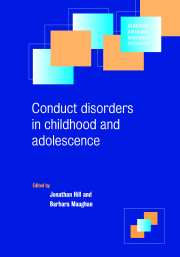Crossref Citations
This Book has been
cited by the following publications. This list is generated based on data provided by Crossref.
Kazdin, Alan E.
2002.
The State of Child and Adolescent Psychotherapy Research.
Child and Adolescent Mental Health,
Vol. 7,
Issue. 2,
p.
53.
Turgay, Atilla
2004.
Aggression and disruptive behavior disorders in children and adolescents.
Expert Review of Neurotherapeutics,
Vol. 4,
Issue. 4,
p.
623.
Scott, Stephen
2006.
A Clinician's Handbook of Child and Adolescent Psychiatry.
p.
522.
Chadwick, Jeanne Joseph
2010.
Handbook of Stressful Transitions Across the Lifespan.
p.
217.
Lavanya, TP
and
Manjula, M
2017.
Emotion regulation and psychological problems among Indian college youth.
Indian Journal of Social Psychiatry,
Vol. 33,
Issue. 4,
p.
312.
Balia, Carla
Carucci, Sara
Milone, Annarita
Romaniello, Roberta
Valente, Elena
Donno, Federica
Montesanto, Annarita
Brovedani, Paola
Masi, Gabriele
Glennon, Jeffrey C.
Coghill, David
and
Zuddas, Alessandro
2021.
Neuropsychological Characterization of Aggressive Behavior in Children and Adolescents with CD/ODD and Effects of Single Doses of Medications: The Protocol of the Matrics_WP6-1 Study.
Brain Sciences,
Vol. 11,
Issue. 12,
p.
1639.
Baird, Alister
Candy, Bridget
Flouri, Eirini
Tyler, Nick
and
Hassiotis, Angela
2023.
The Association between Physical Environment and Externalising Problems in Typically Developing and Neurodiverse Children and Young People: A Narrative Review.
International Journal of Environmental Research and Public Health,
Vol. 20,
Issue. 3,
p.
2549.
Desbiens, Nadia
Bowen, François
Pascal, Sophie
and
Janosz, Michel
2023.
Le programme l’Allié : une alliance autour de l’élève de deuxième ou troisième cycle du primaire manifestant des difficultés de comportement de type externalisé.
Revue de psychoéducation,
Vol. 38,
Issue. 2,
p.
169.



